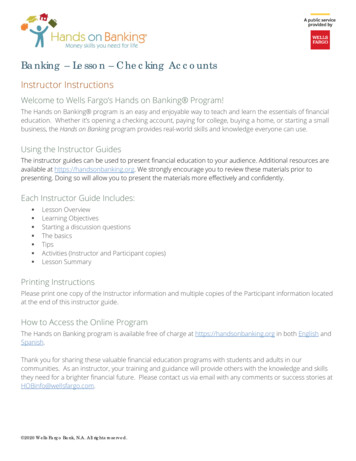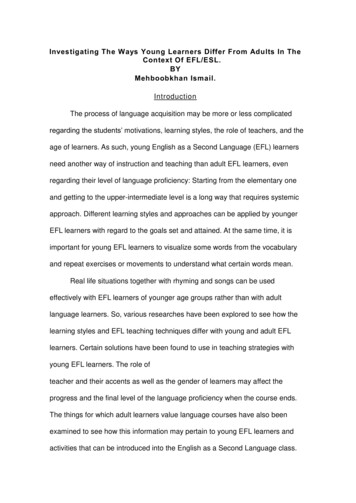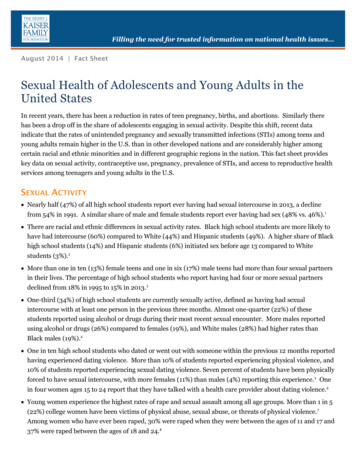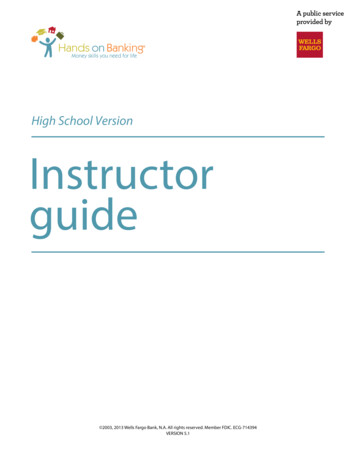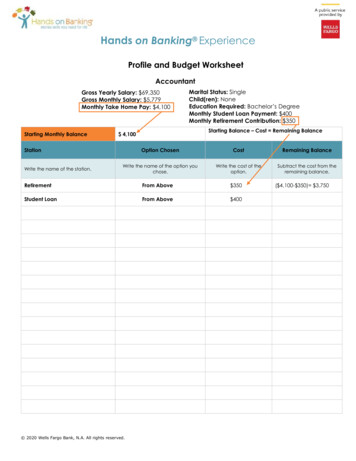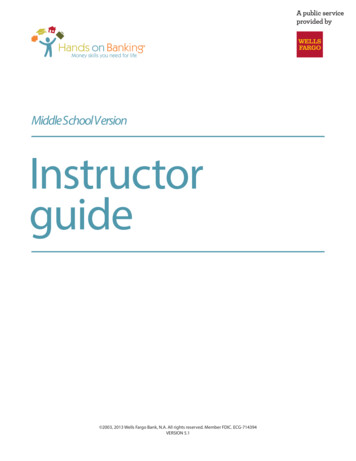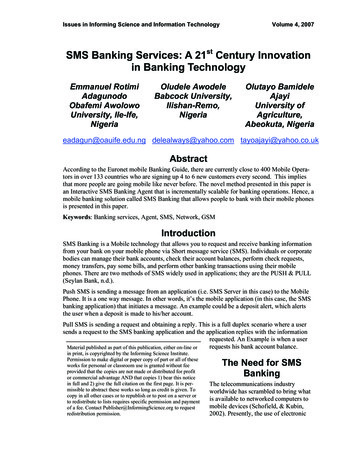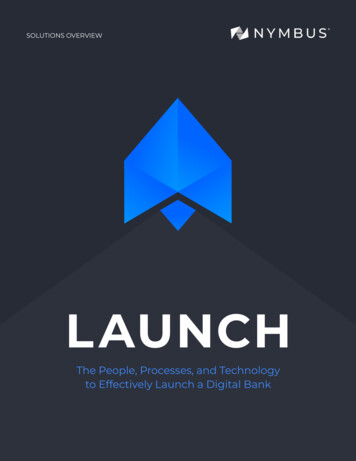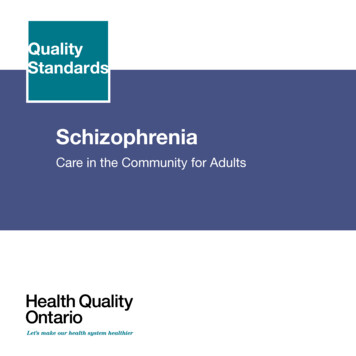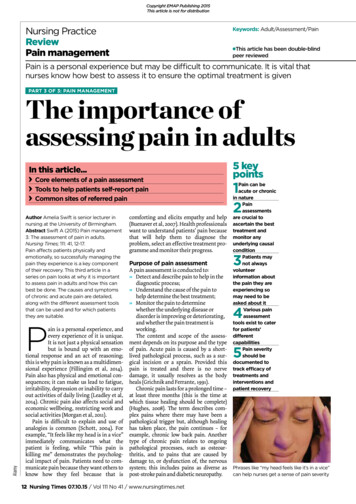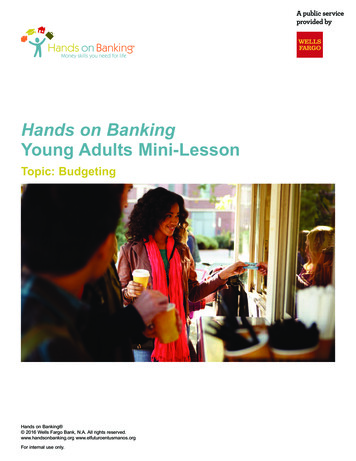
Transcription
Hands on BankingYoung Adults Mini-LessonTopic: BudgetingHands on Banking 2016 Wells Fargo Bank, N.A. All rights reserved.www.handsonbanking.org www.elfuturoentusmanos.orgFor internal use only.
Hands on BankingYoung Adults Mini-LessonTopic: BudgetingAn important part of Wells Fargo’s commitment to help our communities is helping families, parents, and children succeedfinancially. Our goal with this lesson is to help students learn the importance of making smart financial decisions now and inthe future. As a Wells Fargo team member you can have a positive impact on these students and their families by sharingthis classroom lesson.All the resources you need for this lesson are included plus additional support can be found on the Hands on BankingResource Center on Teamworks.Important: Please record any financial education outreach, even if it is part of your job function, at MyVolunteerTime.com.Lesson conceptCreating and using a personal budgetLesson objectiveStudents will become familiar with creating and using a monthly budget and willunderstand the earning power of higher education.Materials neededFor youBusiness card to give to the teacher·······For each studentCopy of the Create a Spending Plan Worksheet (see StudentHandout Section)Copy of the Cost of Living Worksheet (see Student Handout Section)Copy of the Education and Income handout (see Student HandoutSection)Copy of the Easy Steps to Money Success Handout (see StudentHandout Section)Calculator (optional)Hands on Banking or Wells Fargo giveaway items (optional)Coaching tipResourcesTimingFor internal use only.···Review the Young Adults Instructor Guide.Hands on Banking Resource Center on TeamworksHOB Materials & Premiums Order Form to order optional giveaway itemsIntroduction: 10–15 minutesPractice: 20 minutesWrap-up: 5–10 minutesTotal: 35–45 minutes2
Hands on BankingYoung Adults Mini-LessonTopic: BudgetingIntroduction1. Introduce yourself to the class. Share with them a brief description of your role at Wells Fargo.····2. Start the lesson with these opening questions:··Do any of you currently keep a monthly budget?Why do you think you should have a written plan for how you will spend your money?Do you see a plan or budget as a hindrance or a guide? Why?What things do you seem never to have enough money to purchase? How do you think a plan could help youwith that?3. Provide background information and an overview of the lesson.A spending plan can help you make the most of your money and reach your financial goals. It is your personal strategy.A spending plan or personal budget is easy to create. On a piece of paper, write down the money you have comingin—your income— and what you spend—your expenses—in an average month. Putting it down on paper helpsyou see where you can improve and make better money decisions.Gross Income vs. Net Income···There is a difference between your gross income (the total amount you earn) and your net income or take-homepay (the amount of money earned after taxes, insurance, or other costs have been subtracted)Base your spending plan on your take-home pay.There are three types of expenses.Fixed Expenses:» Regular amounts that generally don’t change much.» Monthly expenses like rent or car payments.Flexible Expenses:» Occur on a regular basis and are also for necessities.» You have more control over how much you spend like groceries and utility bills.Discretionary Expenses:» Money you choose to spend, but don’t necessarily have to spend.» Could include clothes, movies, and dining out.··» Savings is a discretionary expense—it’s up to you to decide how much of your money you’re going to set asidefor your future. Don’t forget to “pay yourself” by saving.A spending plan can help you live within your means.Now, let’s practice creating a personal budget.For internal use only.3
Hands on BankingYoung Adults Mini-LessonTopic: BudgetingPractice1. Distribute the Create a Spending Plan Worksheet and the Cost of Living Worksheet to each student.2. Divide the class into two random groups by using the birth month of the students. Have them imagine that they live in“Anytown, USA,” a large metropolitan area, and give them the scenarios below.··January through June birthdays:Imagine you are a junior-level manager at a large company. You completed a Bachelor’s degree at a 4-yearuniversity and have a few years of work experience under your belt. Your monthly take-home pay is 3,200.July through December birthdays:Imagine you are currently a college student. You still do not have the skills for a high paying salary, but it is yourgoal to increase your earning power so you are going to college. You work part-time and have additional monthlyincome from financial aid. Your monthly net income is 1,800.3. Instruct the students to use the Create a Spending Plan Worksheet to create a personal budget based on theinformation in the Cost of Living Worksheet and the scenarios described to them.4. As students are working on this, walk around the classroom and check their progress.5. Distribute the Education and Income handout to each student.For internal use only.4
Hands on BankingYoung Adults Mini-LessonTopic: BudgetingTeacher’s Copy of Create a Spending Plan Worksheet and Cost of Living WorksheetCreate a Spending Plan WorksheetCost of Living WorksheetUse the worksheet below to create a monthly spending plan and track your actual spending. If you have an expensethat is not paid monthly, convert it to a monthly amount. For example, if you pay your car insurance bill every sixmonths, divide the amount of the bill by six.Fixed ExpensesRent*A 1-bedroom apartment is 1,300 a month, and a 2-bedroom apartment is 1,500a month. Choose where you will live. Divide the rent by the number of people whowill share the apartment to determine your portion.Will you have a roommate?If yes, how many roommates will you have?What is your portion of rent?Car Loan PaymentA new car is 450 a month, a used car is 250 a month, or you can travel by bus,which means you don’t have a car loan payment or car insurance.Car InsuranceInsurance for a new car is 180 a month and for a used car it is 120 a month.Bus passA bus pass is 75 a month.Monthly IncomeSalary Other Income Total Monthly Income Fixed ExpensesRent Car Loan Payment Car Insurance Bus Pass Monthly Flexible ExpensesUtilities Internet Cable TV Cell PhoneFlexible ExpensesUtilities*Utilities for the apartment is 100 total. What is your portion?InternetIf you choose to have Internet at home, budget 25 a month for your portion.Cable TVIf you choose to have cable TV, budget 25 a month for your portion.Cell PhoneA smartphone is 100 a month, a basic cell is 40 a month.Gas for the CarIf you plan to drive often budget 150; if you seldom plan to drive budget 100.GroceriesIf you pack your lunch and cook at home frequently, budget 160 a month. If youprefer to dine out, budget 100 for groceries. Gas for the Car Groceries Monthly Discretionary ExpensesDining Out Clothing Entertainment SavingsTotal Monthly Expenses Dining OutIf you spend 100 on groceries, budget 300 on dining out. If you choose to spend 160 on groceries, budget 100 on dining out.ClothingIf you shop for clothes often, budget 300 a month. If you only shop occasionally,budget 200. If you rarely shop for clothes, budget 100.EntertainmentThink about what you like to do for fun (concerts, movies, shows, etc.). If you wantto go out often, budget 400 a month. If you only go out occasionally, budget 200.If you rarely go out, budget 100 a month.SavingsSave at least 10% of your income. Try to save more if you can. Total Monthly Income Minus Total Monthly Expenses Left Over ·Discretionary Expenses* If you choose to have roommates, divide the amount by the number of people in the apartment to calculate your portion.Note to the teacher:·Encourage the students to create a budget within their means that still allows them to save somemoney for the future.Walk around the classroom to ensure students clearly understand the assignment. As you visit students, encourage discussion by asking questions such as:» Did you have to make some tough decisions when creating your budget? What tradeoffs didyou make?» Are you being realistic about how much you would spend on entertainment? Think about howmany times a year you go to concerts or how often you see a movie.» Think about what purchases you might be saving for if you’re a college student or a working professional. How much can you afford to save to reach your goals? Will it take a long time?For internal use only.5
Hands on BankingYoung Adults Mini-LessonTopic: BudgetingTeacher’s Copy of Education and Income HandoutThis chart shows an estimate of the pre-tax yearly earnings of full-time workers ages 25 and older whohave these levels of education:Amount of EducationPre-tax EarningsMaster’s degree 70,000Doctoral degreeBachelor’s degreeAssociate degree 91,000 56,500 44,000Some college, no degree 40,400Not a high school graduate 25,100High school graduate 35,400[Source: The College Board, Education Pays, 2013]Note to the teacher:Go over the information in the handout and cover the following key points:·More education more job options··For some jobs, you don’t need specialized education or training beyond what you learned in highschool. But lots of jobs do require it. And there are lots of options for getting it: trade school, technicalschool, or college.Education beyond high school can give you the kind of knowledge and skills that can lead to morejob and career options.More education more earning power·For internal use only.The level of education you achieve can make a huge difference in how much money you’re ableto earn.During a 40-year full-time working life, the median earnings of bachelor’s degree recipients withoutan advanced degree are 65% higher than the median earnings of high school graduates. [Source:The College Board, Education Pays, 2013]6
Hands on BankingYoung Adults Mini-LessonTopic: BudgetingWrap-up1. Review some key points about creating a personal budget:······It’s simple to create a spending plan—write down how much money comes in during an average month and thendecide how you’re going to spend it.Create a personal budget you can live with. Be realistic and flexible. The trick is to live within your income so youcan pay expenses but still have some money left over for your own flexibility.It’s also important to note that going to college or receiving education beyond high school can potentially lead tomore job options and increase your income or earning power.The right spending plan can help you set aside enough to pay your bills, have some savings for emergencies, andsome money left over in your pocket. It is a good idea to save up to 6 to 8 months of expenses in your emergencyfund. Remember, if you tap into it, you have to replenish it.Savings is a discretionary expense. Don’t forget to pay yourself by saving.Review your plan every month. Adjust it as your income and expenses change.2. Ask if there are any questions about what was covered today or any other questions about how they can managetheir money.3. Distribute the Easy Steps to Money Success handout.4. Remind students that they can learn more about what was covered today—plus much more about all aspects ofmanaging their money—by visiting www.handsonbanking.org.5. Thank the participants for allowing you to spend time with them today.And remember follow-up with the teacher or program director.··Take a few minutes to ask the teacher or program director how they thought the lesson went. Ask if there are othermaterials or information you could provide them.Consider writing a thank you note or email as a follow-up to your visit.Don't forget to record your participation at MyVolunteerTime.com.For internal use only.7
Hands on BankingYoung Adults Mini-LessonStudent Handout SectionTopic: Budgeting
Hands on BankingYoung Adults Mini-LessonTopic: BudgetingCreate a Spending Plan WorksheetUse the worksheet below to create a monthly budget. If you have an expense that is not paid monthly, convert it to a monthly amount. For example, if you pay your car insurance bill every six months, divide theamount of the bill by six.Monthly Fixed ExpensesRent Car Insurance Car Loan PaymentBus PassMonthly Flexible Expenses Utilities Cable TV InternetCell PhoneGas for the CarGroceriesMonthly Discretionary Expenses Dining Out Entertainment ClothingSavingsTotal Monthly ExpensesTotal Monthly IncomeMinus Total Monthly ExpensesLeft OverHands on Banking 2016 Wells Fargo Bank, N.A. All rights reserved.
Hands on BankingYoung Adults Mini-LessonTopic: BudgetingCost of Living WorksheetFixed ExpensesRentA 1-bedroom apartment is 1,300 a month, and a 2-bedroom apartment is 1,500 a month. Choose where you will live. If you have roommates, divide therent by the number of people in the apartment to calculate your portion.Will you have a roommate?If yes, how many roommates will you have?What is your portion of rent?Car Loan Payment A new car is 450 a month, a used car is 250 a month, or you can travel bybus, which means you don’t have to budget for car payment, car insurance, andgas for the car.Car InsuranceInsurance for a new car is 180 a month and for a used car it is 120 a month.Bus PassA bus pass is 75 a month.UtilitiesUtilities for the apartment is 100 total. What is your portion?Cable TVIf you choose to have cable TV, it costs 70. What is your portion?Flexible ExpensesInternetCell PhoneGas for the CarGroceriesInternet service costs 50 a month. What is your portion?A smartphone is 100 a month, a basic cell is 40 a month.If you plan to drive often budget 150; if you seldom plan to drive budget 100.If you pack your lunch and cook at home frequently, budget 160 a month. If youprefer to dine out, budget 100 for groceries.Discretionary ExpensesDining OutClothingEntertainmentSavingsIf you spend 100 on groceries, budget 300 on dining out. If you choose tospend 160 on groceries, budget 100 on dining out.If you shop for clothes often, budget 300 a month. If you only shop occasionally, budget 200. If you rarely shop for clothes, budget 100.Think about what you like to do for fun (concerts, movies, shows, etc.). If youlike to go out often, budget 400 a month. If you only go out occasionally,budget 200. If you rarely go out, budget 100 a month.Save at least 10% of your income. Try to save more if you can.* If you choose to have roommates, divide the amount by the number of people in the apartment to calculate your portion.Hands on Banking 2016 Wells Fargo Bank, N.A. All rights reserved.
Hands on BankingYoung Adults Mini-LessonTopic: BudgetingEducation and IncomeThis chart shows an estimate of the pre-tax yearly earnings of full-time workers ages 25 and older whohave these levels of education:Amount of EducationPre-tax EarningsDoctoral degree 91,000Bachelor’s degree 56,500Master’s degreeAssociate degree 70,000 44,000Some college, no degree 40,400Not a high school graduate 25,100High school graduate 35,400[Source: The College Board, Education Pays, 2013]Hands on Banking 2016 Wells Fargo Bank, N.A. All rights reserved.11
Five Easy Steps for Financial Success1. Use credit to your advantageAs an adult, building good credit andhaving a good credit score is important.So, while a credit card might make iteasier to purchase things you want today,remember that how you manage yourcredit now will affect your options later.FUHGLW QRZ ZLOO DႇHFW \RXU RSWLRQV ODWHU Landlords and employers may also usecredit scores as a decision-making factor.So, rather than thinking of a credit cardas simply a payment method, use yourcredit card as a tool to build good credit.Here’s how: Stay below your credit limit—this showsyou can control your use of credit Pay at least the minimum amount due—better to pay off the entire balance²EHWWHU WR SD\ Rႇ WKH HQWLUH EDODQFHif you can Pay on time—not only does this helpbuild good credit, you avoid late feesas well2. Before you sign on the dottedline, do research )LQG D ¿QDQFLDO LQVWLWXWLRQ WKDW ZLOO SURYLGH you the best rate, terms, and fees onWKH ¿QDQFLDO WRROV \RX QHHG FKHFNLQJ savings, loans, credit card, etc.) Compare student loan repayment plans²JLYH \RXUVHOI VRPH ÀH[LELOLW\ Borrow money only after you have aclear understanding of the “real cost”of repayment3. Consider ways to make yourmoney go further Start a savings account now—compoundinterest allows your money to grow Think about getting a part-time job Buy groceries and eat at home—eatingRXW WRR RIWHQ LV H[SHQVLYH Take advantage of student discounts Look for deals—buy used books, pre-owneddorm furniture, and secondhand clotheswww.handsonbanking.org · www.elfuturoentusmanos.orgHands on Banking 20162015 Wells Fargo Bank, N.A. All rights reserved. Member FDIC.4. Create a budget—spend smart 8VH \RXU EXGJHW SODQ WR VHH H[DFWO\where your money goes Use online tools and resources to trackH[SHQVHV DQG PRQLWRU \RXU DFFRXQWV Pay your bills on time—avoid costly feesDQG ¿QDQFH FKDUJHV Before you spend, ask yourself, “Can Ireally afford this?” If not wait till you canUHDOO\ DႇRUG WKLV" ,I QRW«ZDLW WLOO \RX FDQ A plan puts you in control ofyouryourmoneymoney5. Use the Hands on Banking programThe Hands on Banking program is designedWR KHOS PDNH \RX DQ H[FHOOHQW PRQH\manager. Study all the lessons carefully,and you could be on your way to a moneybright future!
2 Hands on Banking Young Adults Mini-Lesson Topic: Budgeting For internal use only. An important part of Wells Fargo’s commitment to help our commu
